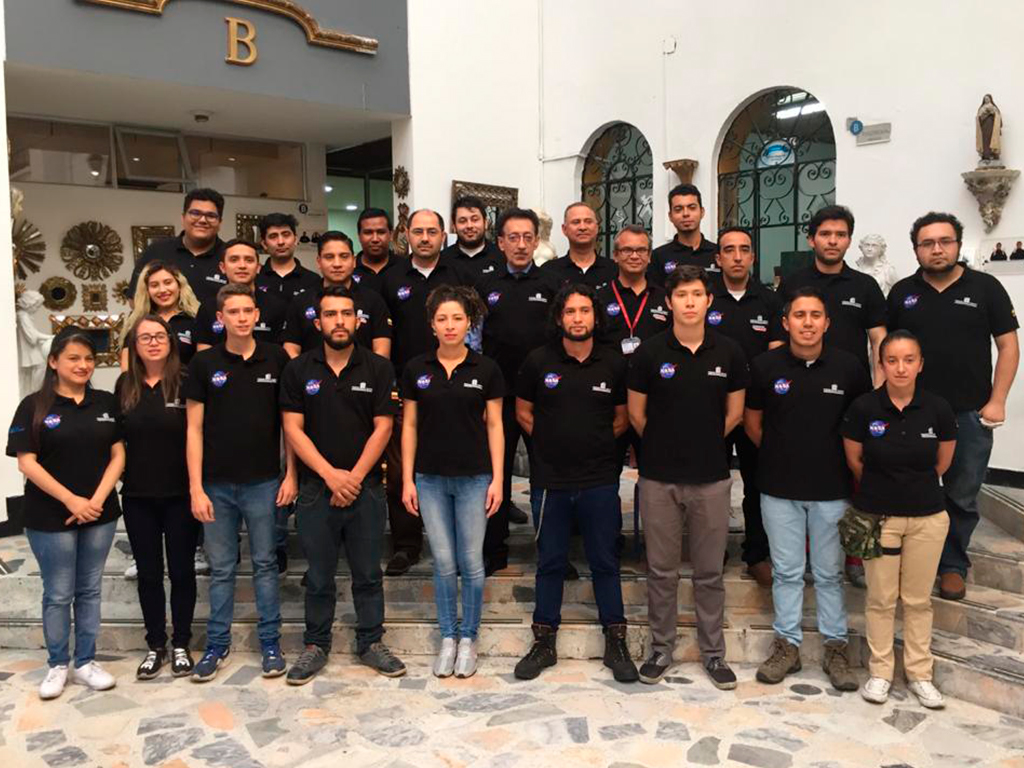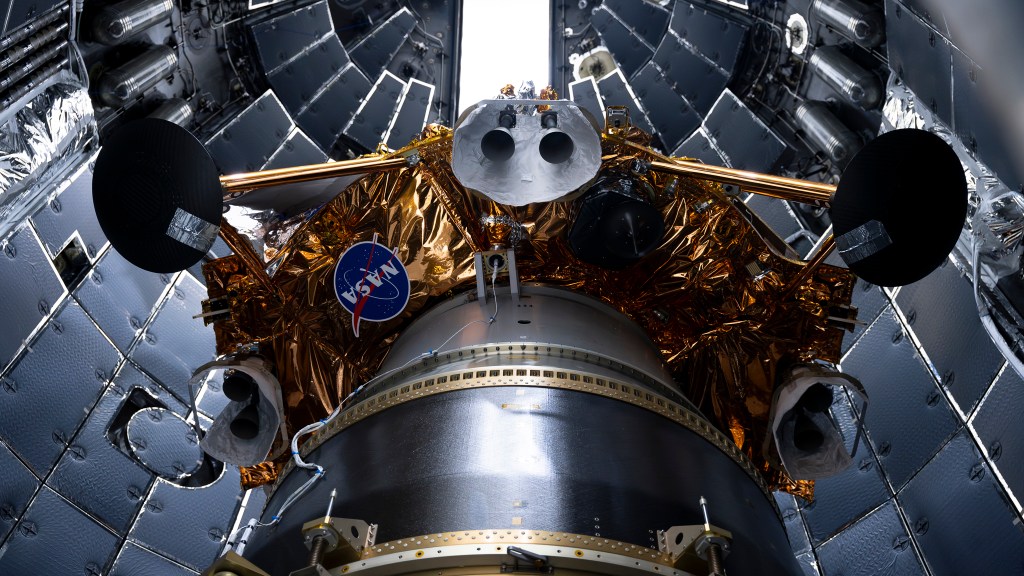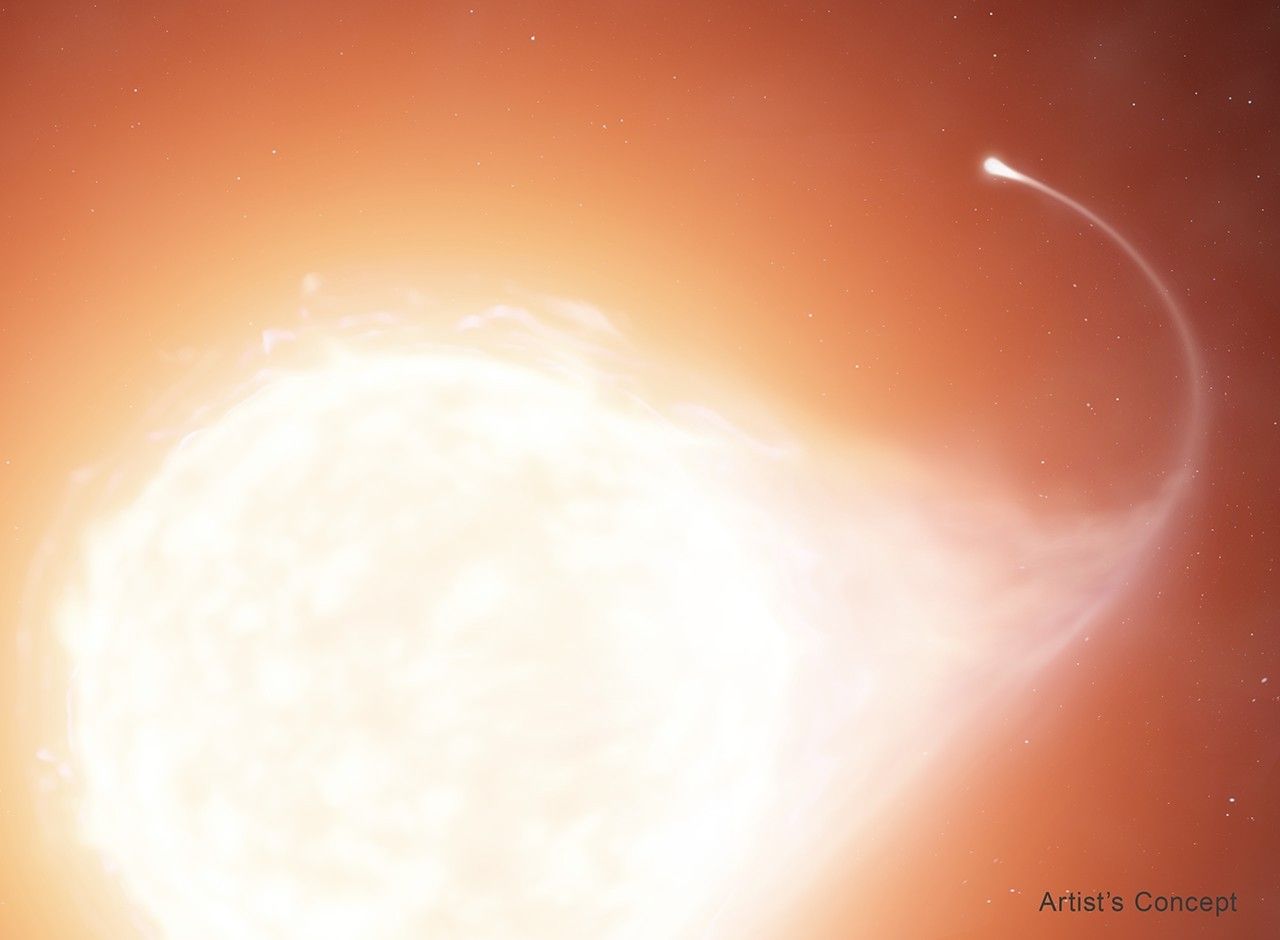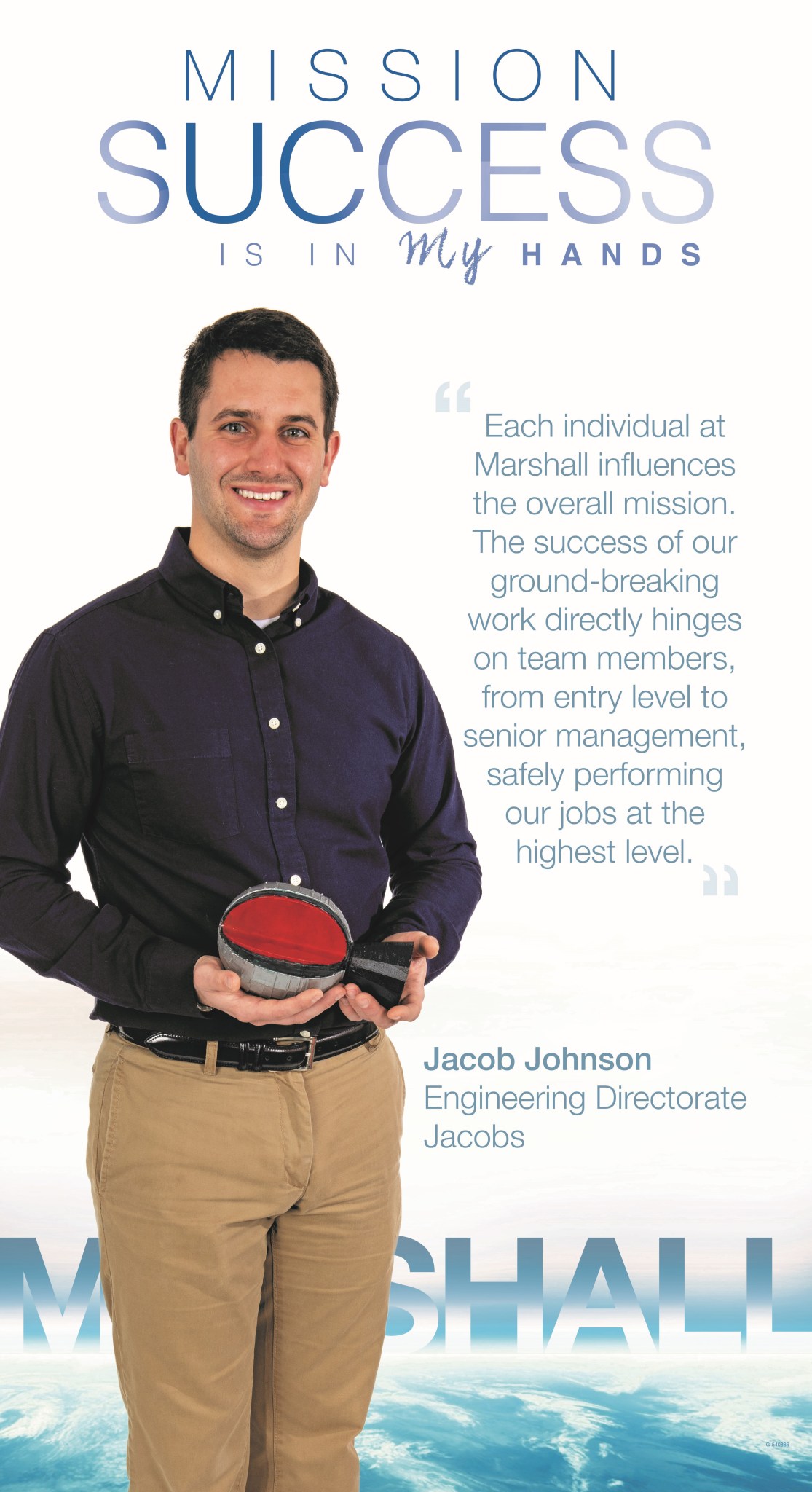In This Week’s Star
- NASA Leaders Hold Virtual Town Hall as Stage 3 Pandemic Protocols – and Flight Mission Preparations – Continue
- To the Moon and Beyond: SLS Flight Support Booster Test
- Mission Complete: NASA Announces Artemis Generation Winners of Human Exploration Rover Challenge
- Mission Success is in My Hands: Jacob Johnson
- NASA’s Innovative Green Propellant Infusion Mission Nears Completion
- Chandra Tracks Supernova Remnant, Shows Stellar Blast Debris Has Not Slowed for 400 Years
- This Week in NASA History: STS-128 Launches – Aug. 28, 2009
NASA Leaders Hold Virtual Town Hall as Stage 3 Pandemic Protocols – and Flight Mission Preparations – Continue
By Rick Smith
As NASA field centers nationwide undertake Stage 3 health protocols in response to the ongoing COVID-19 pandemic, the agency’s senior administrators held a virtual town hall Aug. 20 to offer insight, encouragement, and kudos to NASA team members on a variety of subjects.
A link to the town hall presentation can be found on Inside Marshall.

The online event included remarks by NASA Administrator Jim Bridenstine; Deputy Administrator Jim Morhard; Associate Administrator Steve Jurczyk; Cathy Mangum, acting deputy associate administrator; Jane Datta, deputy assistant administrator for the Office of Human Capital Management; and Dr. J.D. Polk, NASA chief health and medical officer. Bettina Inclán, associate administrator for communications at NASA Headquarters, moderated the discussion.
“I want to thank the amazing workforce here at NASA, which has continued to accomplish stunning achievements even when times are tough,” Bridenstine said.
Among those triumphs: the first successful commercial crew launch to the International Space Station and safe return home of astronauts Robert Behnken and Doug Hurley aboard the SpaceX Dragon; the July 30 launch of the Mars 2020 Perseverance rover, bound for Jezero Crater on the Red Planet; and ongoing Green Run testing of NASA’s Space Launch System core stage, the central piece of rocket hardware set to lift Artemis Generation explorers to the Moon, Mars and beyond in the years to come.
He also noted that NASA has set a date for the Space X Crew-1 mission, the first regular, rotational crew flight to the International Space Station. It will launch in October, just in time to deliver new astronauts to the space station to mark 20 years of continuous human presence in the orbiting science facility.
“It’s important to remember that we were able to accomplish all the things we’ve done so far this year because people have been very careful,” Bridenstine said. “The highest priority for NASA is your safety – whether you’re working at home or on-site.”
Mangum pointed out that most NASA facilities, including Marshall Space Flight Center, undertook these missions and other tasks while observing Stage 4 safety protocols and mandatory telework conditions – and still rose to meet each challenge.
Polk said that NASA’s doing everything possible to keep team members safe while working on-site, including providing personal protective equipment, high efficiency air filters, and enforcing masking and social distancing requirements.
“All the protocols we’ve put in place have done a good job to reduce transmission of this virus,” he said, “but personal responsibility doesn’t start or end at our door.” He urged workers to follow all masking, hand-washing, and social distancing protocols, on-site and when they’re in public.
He also dismissed controversy around different types of protective face coverings, citing a recent article in the medical journal The Lancet.
“Any time you have a face covering, you reduce the risk of transmission,” he said.
To close the event, Bridenstine encouraged team members to sustain their commitment to good health and safety practices.
“We’ve done some really amazing things in the last few months, working through some really challenging times,” he said, “and we’ve still got some really important things to do on behalf of the nation.”
For the latest updates on NASA’s response to the COVID-19 pandemic, team bookmark NASA People or visit Inside Marshall.
Smith, an ASRC Federal/Analytical Services employee, supports the Office of Strategic Analysis & Communications.
To the Moon and Beyond: SLS Flight Support Booster Test

NASA is working to land the first woman and next man on the Moon by 2024. The SLS rocket, Orion spacecraft, Gateway, and Human Landing System are part of NASA’s backbone for deep space exploration. The Artemis program is the next step in human space exploration. It’s part of America’s broader Moon to Mars exploration approach, in which astronauts will explore the Moon. Experience gained there will enable humanity’s next giant leap: sending humans to Mars. SLS is the only rocket that can send Orion, astronauts and supplies to the Moon in a single mission. Credits: NASA/Kevin O’Brien
To support future flights of NASA’s powerful Space Launch System rocket, NASA and Northrop Grumman, the SLS booster lead contractor, will conduct a full-scale Flight Support Booster test in Promontory, Utah, on Sept. 2. The SLS rocket will use two, five-segment solid rocket boosters to help launch NASA’s Artemis missions to the Moon. NASA and Northrop Grumman have completed testing for the boosters used for the first three Artemis missions. The Flight Support Booster test builds upon prior tests of the rocket’s solid rocket booster to evaluate improvements and new materials in the boosters for missions beyond Artemis III. The test will be broadcast live on NASA TV and the agency’s website at 1:40 p.m. Sept. 2. (NASA/Kevin O’Brien)
Mission Complete: NASA Announces Artemis Generation Winners of Human Exploration Rover Challenge
By Will Bryan
While NASA is preparing to send the first woman and next man to the surface of the Moon in 2024 with the Artemis program, the next generation of explorers, engineers, scientists, and spaceflight professionals are sharpening their skills to help the agency establish a permanent presence on the Moon and send the first humans to Mars.
The agency announced the winners of the 2020 NASA Human Exploration Rover Challenge during a virtual awards ceremony posted Aug. 21. The Rover Challenge tasks U.S. and international student teams to design, engineer, and test a human-powered rover on a course that simulates the terrain found on rocky bodies in the solar system. The teams also must perform mission tasks while negotiating the course, including sample retrievals and spectrographic analysis.

Despite the cancellation of on-site competition activities at the U.S. Space & Rocket Center near NASA’s Marshall Space Flight Center due to the global COVID-19 pandemic, high school and college teams competed in multiple design, documentation, and presentation categories, and were recognized for their successful efforts.
“This year, we had 111 teams from 27 states, Washington, D.C., Puerto Rico, and 11 other countries,” said Julie Clift, program manager for the challenge at Marshall. “The teams pushed the limits this year, designing and building truly innovative rovers to take on the challenging course. Although we are disappointed we had to cancel the on-site activities, we are thrilled we are able to recognize and celebrate the teams’ hard work and creativity.”

Awards were presented in eight categories.
AIAA Neil Armstrong Best Design Award
- High School Division: Escambia High School, in Pensacola, Florida
- College/University Division: Middle Tennessee State University – Team 2, in Murfreesboro
Technology Challenge Award
- Universidad Nacional de Ingeneiria, in Lima, Peru
Drive Train Technology Challenge
- Universidad ECCI, in Bogota, Colombia
AIAA Telemetry/Electronics Award
- Tecnológico de Monterrey, in Morelos, Mexico
AIAA Best Report Award
- High School Division: Parish Episcopal School – Team 1, in Dallas
- College/University Division: Trine University, in Angola, Indiana
System Safety Challenge Award
- High School Division: Mount Juliet High School, in Mount Juliet, Tennessee
- College/University Division: Instituto Tecnológico De Santo Domingo, in Santo Domingo, Dominican Republic
STEM Engagement Award
- High School Division: Blue Ridge High School, in Lakeside, Arizona
- College/University Division: Universidad ECCI
Task Challenge Award
- High School Division: Saint Thomas Academy, in Mendota Heights, Minnesota
- College/University Division: University of Alabama in Huntsville
The competition is one of seven NASA Artemis Student Challenges the agency hosts to engage and inspire the Artemis Generation. It is sponsored by NASA’s Human Exploration and Operations Mission Directorate and Office of STEM Engagement Next Gen STEM in Washington; and managed by Marshall’s Office of STEM Engagement.
The challenge was launched in 1994 as the NASA Great Moonbuggy Race to commemorate the 25th anniversary of the Apollo 11 lunar landing. Just six college teams participated that first year. Expanded in 1996 to include high school teams, the race evolved again in 2014 into the Human Exploration Rover Challenge. Since the challenge’s inception, more than 12,000 students have participated.
For more information about NASA’s Human Exploration Rover Challenge, visit here.
For more information about NASA’s Artemis Student Challenges, visit here.
Bryan, an ASRC Federal/Analytical Services employee, supports the Office of Strategic Analysis & Communications.
Mission Success is in My Hands: Jacob Johnson
Editor’s note: This is the fifth in a series of articles spotlighting how team members at NASA’s Marshall Space Flight Center make meaningful connections between their jobs and the safety and success of NASA’s missions. The Mission Success Is in Our Hands initiative is a centerwide campaign led by Marshall’s Safety and Mission Assurance Directorate and partner Jacobs Engineering of Huntsville. It promotes and strengthens the center’s focus on mission, hardware, and crew safety.
By Rick Smith
There’s an old adage which pins the cost of a fallen kingdom on a missing horseshoe nail. The lack of a nail causes the shoe to be lost, which in turn causes the horse to be lost, its rider, a critical battle, and ultimately the realm – a reminder that even the largest, most complex system functions only as well as its smallest component part.
Jacob Johnson, a Jacobs Engineering contractor on the Engineering Services and Science Capability Augmentation contract supporting the Engineering Directorate at NASA’s Marshall Space Flight Center, applies that analogy to people as well as hardware.
“Each individual at Marshall influences the overall mission,” said Johnson, an engineering technician. “The success of our groundbreaking work directly hinges on team members – from entry level to senior management – safely performing our jobs at the highest level.”
Johnson is part of the team that provides critical engineering support services to prepare NASA’s Space Launch System for flight. The most powerful rocket ever built, SLS is being readied to carry Artemis Generation explorers to the Moon and enable new missions to Mars and beyond.
“I work in a multidiscipline team environment, alongside mechanical, electrical, and instrumentation engineers and machinists, to perform test preparations and test activities, specifically high-pressure and cryogenic – or deep-cold – test operations for SLS and other NASA programs,” he said.
That testing primarily involves verification and validation of main engine propulsion system components – valves, actuators, ducts, and more, or the “horseshoe nails” that underpin the whole mission – to determine how they function when subjected to simulated flight operations and conditions, from the bone-rattling energy of liftoff to the subzero temperatures of airless space.
Marshall’s team of government and commercial engineering experts use comprehensive, state-of-the-art machine shops and test facilities to design, develop and test advanced hardware materials, components, subsystems, subscale motors, and full-scale engines under a variety of configurations and conditions, to pursue a wide range of in-space and deep space objectives.
“I participate in component testing from initial concept design and specification through final hardware testing and verification for systems integration and launch – coordinating every step of the way with test engineers and customers regarding hardware and component layout, installation, operation, and maintenance,” he said.
Johnson, a native of Fayetteville, Tennessee, earned an associate degree in 2013 from Motlow State Community College in Smyrna, Tennessee. He was a NASA student intern before being hired by Jacobs after graduation as a mechanical engineering technician intern. Since then, he’s contributed to the directorate’s work in a number of capacities. He’s been a machinist, delivering component parts perfectly crafted to specification, has served in configuration control – a systems engineering process for establishing and maintaining hardware performance, safety, and reliability from initial design to lifetime operation – and continues to contribute to SLS development and testing as an engineering technician.
He enjoys delivering reliable SLS propulsion components that will underpin humanity’s next triumphant chapter in spaceflight and scientific discovery.
“We’re all working together to achieve a common goal – to establish the foundation for human exploration beyond Earth’s orbit,” Johnson said. “One day I’ll be able to tell my grandchildren about the role I played in the pioneering, barrier-shattering SLS program.”
All the horses solidly shod, thanks to the Marshall engineering team – and the whole solar system just waiting to be won.
Smith, an ASRC Federal/Analytical Services employee, supports the Office of Strategic Analysis & Communications.
Previous Mission Success is in My Hands profiles
Rebecca Crownover, Marshall’s Component Development Area team lead
Chip Walraven, senior systems engineer for spacecraft and vehicle support in Marshall’s Engineering Directorate
Gwendolyn Artis, launch vehicle stage adapter technical assistant for NASA’s Space Launch System Program at Marshall.
Angelia Walker, deputy director of the Spacecraft and Vehicle Systems Department at Marshall
NASA’s Innovative Green Propellant Infusion Mission Nears Completion
By Lance D. Davis
NASA has validated a new, less toxic, “green” propellant for spacecraft of all sizes. Thanks to NASA’s Green Propellant Infusion Mission – an innovative new propulsion system and fuel option tested in space for a little more than a year since its launch in 2019 – future space missions can forego the conventional and highly toxic propellant hydrazine in favor of a more practical and environmentally friendly solution.
The flight mission set out to test a monopropellant – a chemical propellant that can burn by itself without a separate oxidizer – called Advanced Spacecraft Energetic Non-Toxic, or ASCENT. Formerly known as AF-M315E, the propellant was invented by researchers at the U.S. Air Force Research Laboratory as a hydrazine alternative.
“This is the first time in 50 years NASA has tested a new, high-performing monopropellant in space,” said Tim Smith, GPIM mission manager at NASA’s Marshall Space Flight Center. “It has the potential to supplement or even replace hydrazine, which spacecraft have used since the 1960s.”
The mission is one of NASA’s successful Technology Demonstration Missions, an agency program, led at Marshall, which seeks to mature innovative technologies that offer significant advances for a variety of future spaceflight and exploration endeavors. Such progressive leaps in technology are crucial as NASA prepares to send Artemis Generation explorers to the Moon and on to Mars.
GPIM’s effective demonstration of the new propellant paved the way for NASA’s acceptance of ASCENT in new missions. It will next be used to propel the Lunar Flashlight mission, sending a small spacecraft to the Moon to provide clear-cut information about the presence of water deposits inside lunar craters. The Lunar Flashlight mission will launch as a secondary payload on Artemis I, the first integrated flight test of NASA’s Orion spacecraft and Space Launch System rocket.
Despite being pink in color, ASCENT is considered green for its significantly reduced toxicity compared to hydrazine, which requires protective suits and rigorous propellant loading and processing procedures to ensure worker safety. ASCENT is safer to store and use, and requires minimal personal protective equipment, such as lab coats, goggles, and gloves. The new, higher performance propellant also will allow spacecraft to travel farther or operate longer using less propellant.
But to test its practical use in space, the GPIM team had to develop hardware and systems compatible with the liquid. Aerojet Rocketdyne of Redmond, Washington, designed and built the five onboard thrusters. Aerojet Rocketdyne and Ball Aerospace of Boulder, Colorado, co-designed the other elements of the propulsion system. Ball Aerospace, selected by NASA to lead the mission in 2012, also built the mini-refrigerator-sized spacecraft, integrated and tested the payloads and propulsion system before launch, and supports all flight operations.
The orbiting spacecraft enabled testing of the propellant and propulsion system, including the thrusters, tanks, and valves, via a planned series of orbital maneuvers. Attitude control maneuvers – the process of maintaining stable control of a satellite – and orbit lowering validated expectations about the propellant’s performance, and yielded a 50% increase in spacecraft “gas mileage” compared to hydrazine.
With its technology demonstration objectives nearly complete, the mission proved ASCENT and the compatible propulsion system are a viable, effective propellant alternative for NASA and the commercial spaceflight industry, Smith said.
“We can attribute GPIM’s success to a strong partnership,” he added.
“We are excited to announce flight operations have been very smooth, with the new propulsion subsystem operating as we anticipated,” said Christopher McLean, GPIM principal investigator for Ball Aerospace. “We greatly appreciate the partnership and continuous support throughout this mission from NASA’s Space Technology Mission Directorate, and the program management office at Marshall.”
The spacecraft has started a series of approximately seven deorbit burns, which are expected to lower its orbit to about 110 miles and deplete the propellant tank. The craft will burn up in Earth’s atmosphere upon reentry, anticipated in late September.
Davis is a public affairs officer in Marshall’s Office of Strategic Analysis & Communications.
Chandra Tracks Supernova Remnant, Shows Stellar Blast Debris Has Not Slowed for 400 Years
New data from NASA’s Chandra X-ray Observatory shows material blasting away from the site of an exploded star at speeds faster than 20 million miles per hour, or about 25,000 times faster than the speed of sound on Earth.
The Kepler supernova remnant is debris from a detonated star in the Milky Way galaxy, some 20,000 light-years from Earth. Early astronomers, including Johannes Kepler, who became the object’s namesake, first detected the supernova explosion that destroyed the star in 1604.
Kepler’s supernova remnant is the aftermath of a so-called Type Ia supernova, in which a small, dense white dwarf star exceeds a critical mass limit after interacting with a companion star. The resulting thermonuclear explosion shatters the white dwarf and hurls its remains outward.
The latest study tracked the speed of 15 small “knots” of debris in the Kepler supernova remnant, all glowing in X-rays. The fastest of these knots was measured at a speed of 23 million miles per hour, the highest ever detected via X-rays among supernova remnant debris. The average speed of the knots is about 10 million miles per hour, and the blast wave is expanding at about 15 million miles per hour.
The results independently confirm the 2017 discovery of knots travelling at speeds more than 20 million miles per hour in the Kepler supernova remnant, as published in The Astrophysical Journal in August 2017.
Astronomers studying the newest data estimated the speeds of the knots by analyzing Chandra X-ray spectra, which give the intensity of X-rays at different wavelengths. By comparing the wavelengths of features in the X-ray spectrum with laboratory values and factoring in the Doppler effect – or changes in wavelength due to the relative motion of the source toward or away from the observer – researchers measured the speed of each knot along the line of sight from Chandra to the remnant. They also used Chandra images obtained in 2000, 2004, 2006 and 2014 to detect changes in position of the knots and measure their speed perpendicular to the observer’s line of sight.
The 2017 work applied the same general technique as the new study, but used X-ray spectra from a different Chandra instrument. The new study offers more precise determination of the knot’s total speeds in all directions.
The high speeds in Kepler are similar to those seen in optical observations of supernova explosions in other galaxies only days or weeks after the blast, well before a supernova remnant forms decades later. This comparison implies that some Kepler knots have barely slowed down in the four centuries since the explosion.
The reason for the sustained high speed of the material is unclear. Some scientists have suggested the Kepler supernova remnant is from an unusually bright Type Ia, which might explain the fast-moving material. It is also possible that the immediate environment around the remnant is itself clumpy, which could allow some of the debris to punch through low-density regions without much deceleration.
The new results have been reported in a paper led by Matthew Millard, from the University of Texas at Arlington, and published in an April issue of The Astrophysical Journal. The X-ray spectra used by Millard and his collaborators were obtained with the Chandra High Energy Transmission Grating.
NASA’s Marshall Space Flight Center manages the Chandra program. The Smithsonian Astrophysical Observatory’s Chandra X-ray Center controls science from facilities in Cambridge, Massachusetts, and flight operations from Burlington, Massachusetts.
Read the full NASA feature on the new Chandra findings here.
This Week in NASA History: STS-128 Launches – Aug. 28, 2009

This week in 2009, space shuttle Discovery, mission STS-128, launched to the International Space Station on the 30th mission dedicated to the assembly and maintenance of the orbiting lab. Discovery carried the Leonardo Multi-Purpose Logistics Module, a pressurized module that brought equipment, experiments, and supplies to and from the station. Here, astronaut Danny Olivas participates in the mission’s first spacewalk as construction and maintenance of the station continued. Today, the Payload Operations Integration Center at NASA’s Marshall Space Flight Center serves as “science central” for the space station, working 24/7, 365 days a year in support of the orbiting laboratory’s science experiments. After 20 years of continuous human presence, the space station remains the sole space-based proving ground and stepping stone toward achieving the goals of the Artemis program. The NASA History Program is responsible for generating, disseminating, and preserving NASA’s remarkable history and providing a comprehensive understanding of the institutional, cultural, social, political, economic, technological, and scientific aspects of NASA’s activities in aeronautics and space. For more pictures like this one and to connect to NASA’s history, visit the Marshall History Program’s webpage. (NASA)




























